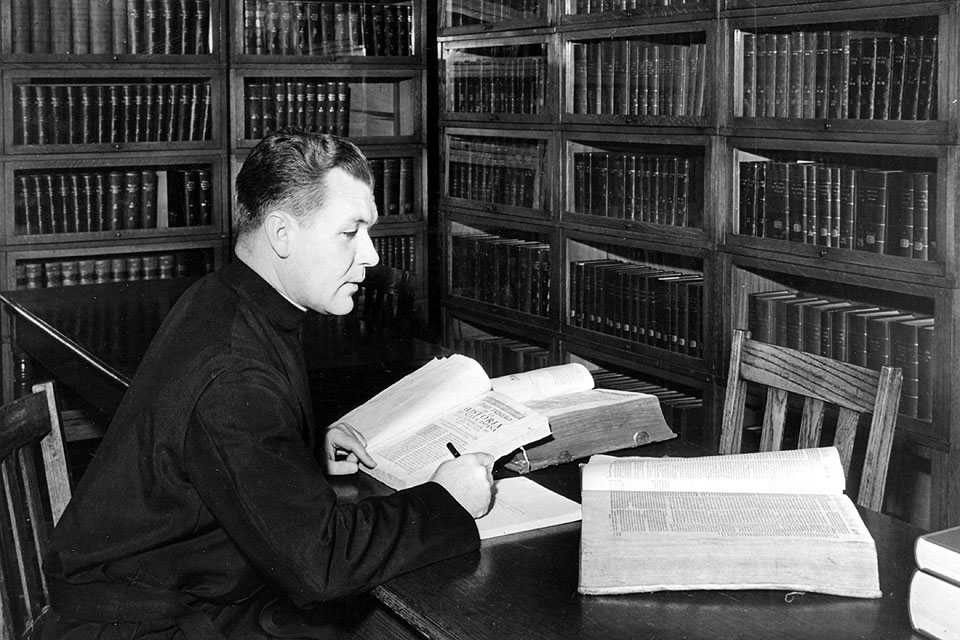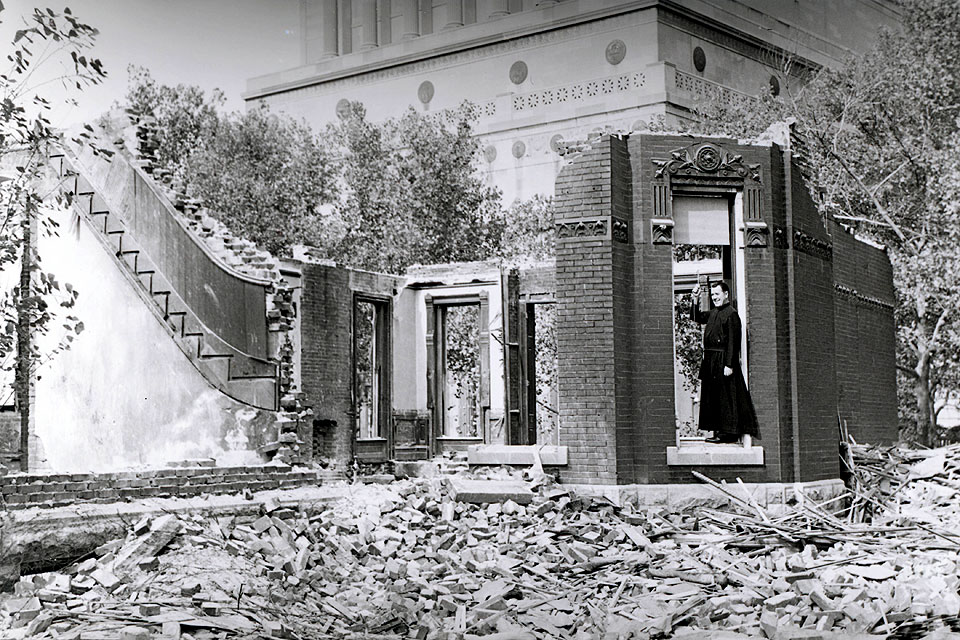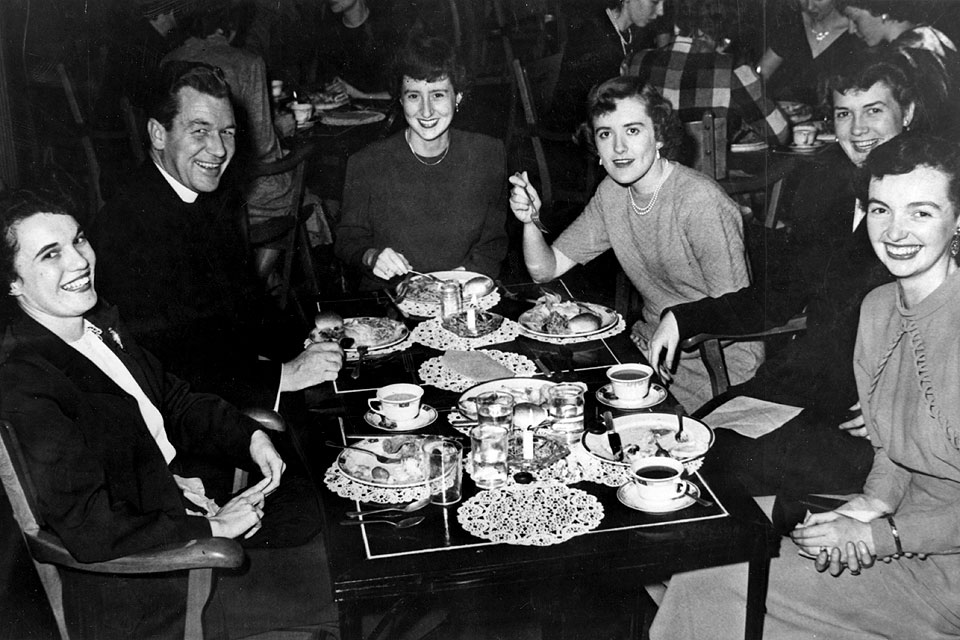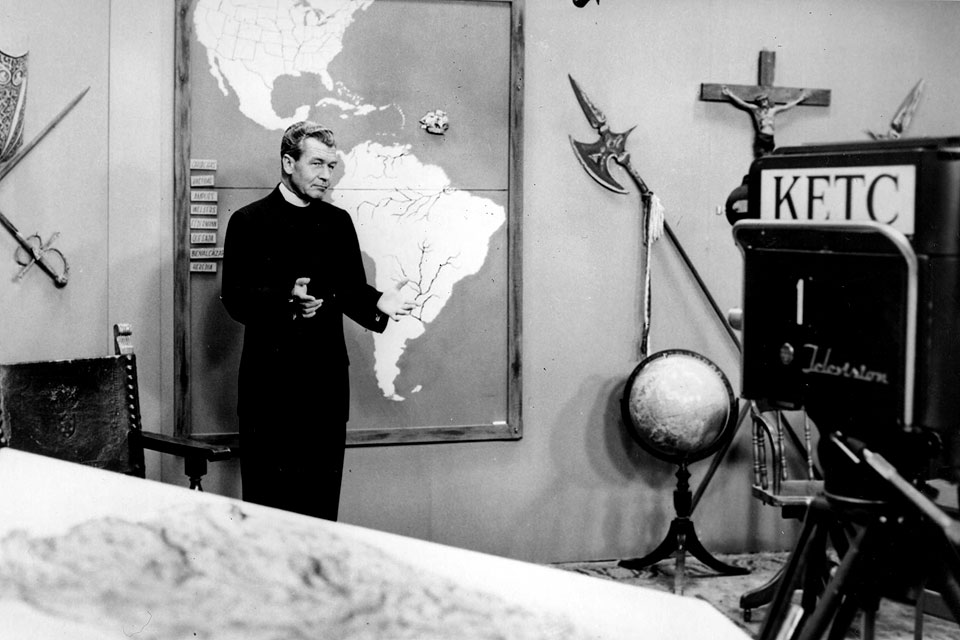SLU Legends and Lore: John Francis "Jack" Bannon, S.J.
He explored troves of historic documents and told stories filled with Native American leaders, missionaries, conquistadors and founding fathers.
From television specials to airline brochures to majorly scholarly works, John Francis “Jack” Bannon, S.J., a Saint Louis University historian and internationally-renowned scholar brought history and the story of America to life.
The West in His Blood
John Francis “Jack” Bannon was born in St. Joseph, Missouri, on April 28, 1905, the eldest of two sons born to William Joseph and Clara Shortle Bannon.
A fascination with the West seemed to run in the family as his younger brother, James, became an actor who played the role of Western hero Red Ryder on television.
After entering the Society of Jesus and his ordination as a priest in 1935, Bannon taught at colleges and universities in Kansas, Colorado and Wisconsin before undertaking graduate studies in history at the University of California at Berkeley (UC Berkeley). While there, Bannon caught the eye of historian Herbert E. Bolton, a renowned scholar of the Spanish borderlands.
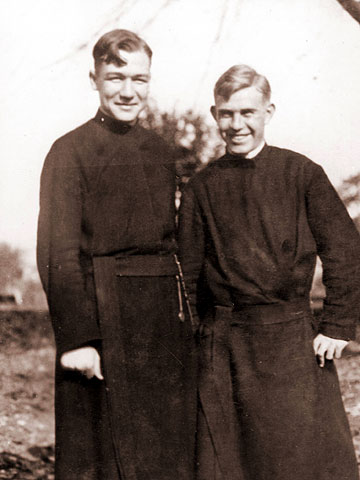
Bolton had been seeking a Jesuit to help him delve into work in the treasure trove of materials documenting Jesuit missionary activities in colonial Mexico. As they worked together, Bolton became Bannon’s mentor, eventually inviting Bannon to his “famous “Round Table” seminars.
In the spirit of Bolton’s work re-envisioning the Spanish borderlands, and focused on studying the work of the storied Jesuit missionary Eusebio Kino, S.J., Bannon traveled to and visited Sonora in keeping with Bolton’s plan of combining actual field work with the study of the many archival documents at the Bancroft Library at the UC Berkeley.
He earned his doctorate in history under Bolton’s tutelage in 1939.
Bannon’s Life Before SLU
- Brought up in Kansas City, Missouri, Bannon attended Our Lady of Perpetual Help, a Redemptorist grade school from 1910 to 1918, and Rockhurst Jesuit High School, graduating in 1922.
- After graduating, he entered the Society of Jesus at St. Stanislaus Seminary in Florissant, Missouri, and he took his first two years of philosophy studies at Florissant from 1922 to 1924.
- After taking his first Jesuit vows at St. Stanislaus in September 1924, Bannon studied at Saint Louis University. He received his bachelor’s degree from Saint Louis University in 1928.
- From 1926 to 1929 he continued his studies at Maison Saint Louis on Jersey, the Channel Islands, United Kingdom, the philosophate of the Paris Province of the Society.
- Following his studies, Bannon was stationed at St. Mary’s College in Kansas, teaching history, French, and Spanish at both the college and at St. Mary’s College High School. He later taught history, French and Spanish at Regis College (now Regis University) in Denver, Colorado, and was ordained a priest at St. Mary’s on June 23, 1935.
- In the summer of 1936 he taught history at Marquette University in Milwaukee, Wisconsin. Between 1937 and 1939 he studied history and anthropology at the University of California at Berkeley, receiving his Ph.D. in 1939.
Bannon Becomes a Billiken
After teaching history for the summer at the University of San Francisco, Bannon began his 34-year career as an active faculty member in SLU’s Department of History in the College of Arts and Sciences in the fall of 1939. In 1943, he became the department’s chair, a position he held for 28 years, before retiring in 1973 as professor emeritus of history.
As department chair, Bannon disliked what he considered administrative “red-tape” that interfered with the education of students. Throughout his teaching career, he developed warm personal relationships with his students, particularly with his graduate students. It was said that Bannon could remember the name of each one of his students, and he became a close friend to many over his nearly 30 years at SLU.
During his years at SLU, Bannon became an internationally recognized scholar. He authored more than a dozen books and hundreds of articles and reviews.
Two of his best known books were his two-volume History of the Americas, which was widely used as a text in many American universities, and Herbert Eugene Bolton: The Historian and the Man.
Bannon came to be recognized as an authority on the early trans-Mississippi West and colonial Latin America, and like Bolton, he regarded the histories of North and South America as inseparable parts of the story of the hemisphere as a whole.
Bannon co-founded the Western Historical Association and served as its president from 1965 to 1966. He was on the board of editors of the Hispanic-American Historical Review and on the executive council of the American Catholic Historical Association.
He served as program chairman of the Mississippi Valley Historical Society (later part of the Organization of American Historians) four times, and he hosted its St. Louis meeting in 1955.
Bannon’s Other Scholarly Achievements
- In 1955 he chaired the Conference on Latin-American History of the American Historical Association (AHA).
- He edited the Historical Bulletin at Saint Louis University between 1943 and 1950 and was advisory editor for Manuscripta when it appeared as a new publication of the Pius XII Memorial Library.
- After his 1973 retirement, Bannnon produced a booklet for each academic department in the University. These booklets contained the name and rank of each faculty member in the department and their academic biography for each year from the early 1920s until 1978.
- The booklets also listed the names and academic background of each graduate student in the department, as well as the title of their dissertation, and contained statistics on the number of majors and graduate students in each department for every year.
- In 1983, an endowed fund was established in Bannon’s honor for the benefit of the Department of History. Soon after, Genevieve “Genie” James, a long-time University friend and benefactor, helped transform the fund into an endowed professorship named in Bannon’s honor.
Bridging the Past and Present for the Public
In addition to these more traditional scholarly accomplishments, Bannon became a household face for many St. Louisans and history buffs nationwide through his work in early educational television.
In 1954, working with KETC-TV Ch. 9, the first public television station in St. Louis, Bannon presented a series of thirty-six half-hour talks on the “History of the United States.”
As he did in his SLU classroom, Bannon set the scene for viewers as he told stories of the Western Hemisphere’s past, using a variety of maps, a teacher’s desk, crossed halberds, a crucifix, and the coat of arms of Spain and Portugal.
The National Education Television and Radio Center in Ann Arbor, Michigan, picked up Bannon’s programs. Viewers in 20 cities across the United States eventually fell under Bannon’s spell.
In 1956, Bannon created thirty more television programs on “The Great American West” which could be taken for academic credit at SLU. A year later, Bannon developed another series of programs on “The Latin Americas” for telecast in St. Louis and across the country.
Versatile and eager to reach diverse audiences, Bannon wrote two in-flight booklets for travelers on American Airlines: “History Below the Jet Trails” and “West to the River.”
A Historian’s Story Continues
Bannon formally retired from the history department in 1973. After his retirement, he remained intellectually active, holding the several visiting professorships, conducting research and writing about SLU history and the history of the Missouri Province of the Society of Jesus. He died on June 5, 1986, at age 81 in St. Louis.
But his legacy of scholarship and of sharing the stories and lessons of the past with the public lives on as the Department of History hosts its annual John Francis Bannon, S.J., Lecture.
And, in the spirit of his mentor, Bannon ensured that others could continue to explore the past through the artifacts housed in archives. After his formal retirement, Bannon served as “de facto” archivist for the University, collecting copies of University catalogs, bulletins, yearbooks, SLU publications, photographs and collections of academic papers of several Jesuit faculty members to preserve SLU’s story for future generations.
Today, the materials Bannon collected are constantly used by patrons and staff in the current University Archives.
After 200 years, there are many legends and untold tales hiding in the nooks and crannies of Saint Louis University. Delve into the myths, fables, fantastic lives, moments and surprises you will find in its story with “SLU Legends and Lore.”
Story based on the "SLU Legends and Lore" Bicentennial Series by John Waide, University archivist emeritus.


















